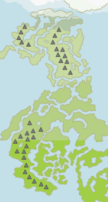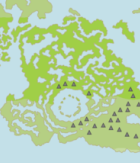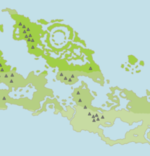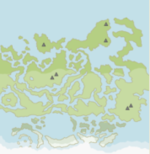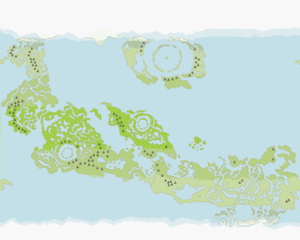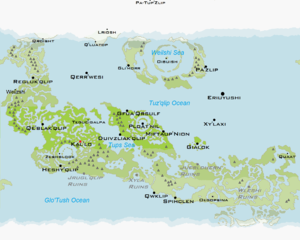User:Caelphon
| Skrell Lore Pages | ||
|---|---|---|
| Skrell | Skrell Ethnicities · Skrell Relationships · Skrell Ailments · Notable Skrell | |
| Planets, Systems, Settlements | Qerrbalak · Qerr'Malic · Aliose · Aweiji · Tattuqig · Diulszi · Skrell Abroad · Notable Skrell Systems and Locations | |
| Organizations, Factions, Politics | Nralakk Federation · Skrell Politics and Enforcement · Federation Crime and Resistance · C'thur in the Federation · Dionae in the Federation · Generation Fleets | |
| Culture, Society, History | Skrell Culture · Skrell Cinema and Idols · Skrell Education · Skrell Cuisine · Skrell History · Skrell Beliefs · Skrell Refugees · Skrell Mythology | |
Qerrbalak, the Homeworld
Qerrbalak is the fourth planet from Nralakk, and the origin of the Skrell. One of two habitable planets within the system, comprised of various climates ranging from taigas to tropical rainforests. Qerrbalak is 1.8 times the size of Earth, and sports an atmospheric composition of 82% Nitrogen, 17% Oxygen and 1% other. Qerrbalak is currently undergoing slow terraforming efforts to reduce the damage inflicted by the Skrell during unenlightened times.
Environment
Qerrbalak does not have much diversity in biomes, however, is perfect for the Skrell. Largely very humid, and marshy, with most of it being covered in freshwater and saltwater seas, The saline levels are lower than most seas elsewhere; which his uniquely suits the Skrell, as they can safely survive in any of the seas across the Homeworld. It also has polar icecaps, where some Skrell Research Facilities are located and the Headquarters of the Kala.
Before the Skrell entered an era of profound modernisation, Qerrbalak was rich in abundant mineral deposits - both in the planet's deep oceans and its surface. It quickly changed as the Skrell poured resources into pillaging their planet, with little regard for conservation of the resources until it was too late. Now, Qerrbalak orbits Nrallak will little resources left to extract, which prompted the erection of the Jux'Qwi Monument - a reminder that exponential growth cannot go unchecked.
Cities destroyed by the enormous storms still litter Qerrbalak - now sprawling ruins that are uninhabited by the Skrell, instead just husks of their previous metropolis status. These cities remain untouched and used to teach young Skrell about the damage done by the massive storms - with many comparing it to an analogy of life.
Regions
Eqloq
Ranging from the arctic mountains of Speqdor to the humid swamps of Agroriq, Eqloq is an example of the diversification of biomes exposed to the Skrell on the Homeworld. Qroisht, the northernmost skrellian settlement on Eqloq, holds rather conservative ideals in regards to the Jargon Federation; mostly due to their relative isolation in part to their nearest neighbour being over ten thousand kilometres away within the arctic regions of Ucra. This has allowed a somewhat insular culture to form, with staunch xenophobic tendencies. Most work within Qroisht revolves around the slimes since their introduction to the Orion Spur, allowing for the inhabitants of the settlement to gain the nickname "Slime Ranchers". Skrell from here typically share similar biological characteristics with those from Aliose. A large majority of the inhabitants here are Qeblak.
Regluk'qlip, the powerhouse of the region, nestles itself deep within the temperate beaches of Eqloq. A large majority of Regluk'qlip will typically find itself devoted to scientific innovations which has allowed for innovative competition to flourish within the city, and has pushed for it to gather the largest non-Skrell population across the Homeworld; comprised of mostly C'thur and Dionae with some small communities of humans even finding themselves within the city. The sheer presence of these non-Skrell has allowed the culture of the region to enter a somewhat second renaissance as they splice together to create a highly liberal and progressive approach to the outlook of life. A large majority of the followers here are agnostic or follow a different religion to that of the Skrell.
Weuzshi, the western and southernmost settlement of Eqloq. Resting along the western coastline of Eqloq, Weuzshi has formed into a somewhat important agricultural powerhouse on the Homeworld. The proximity to the rivers flowing through Eqloq has allowed it to produce massive quaintities of Dyn and other foodstuffs (such as the Aqolizs). Weuzshi has developed into a rather quaint farming town, with most of those within devoting their lives to the botanical sciences to help grow to fulfil the requirements set out by the Jargon Federation. The farms spans hundreds of miles, with a good portion of the surrounding land being simply just farms. Skrell from here will usually suffer from skin conditions; such as flaking, dry skin. This is due to the aeroponics usually maintaining a very specific moisture level, and humidity which is considered far too low for the Skrell. Most of the issue can be remedied with regular bathing. Weuzshi hosts an equal level of Weishii and Qeblak followers.
Ocror
Ocror is considered the "origin-point" of the Skrell, as a species. The low-lying swamps and valleys within Ocror are typically attributed to the collision of a large asteroid with the Homeworld, roughly four billion years ago. It is believed that this asteroid carried the building blocks of life itself, which sparked the evolution of Skrell on Qerrbalak. Ocror hosts roughly five cities, along with the Capital.
Qe'blak'qlip is one of few cities across the entirety of the Jargon Federation devoted to upholding the faith known as Qeblak. Established in the early days when the Skrell began developing their societies into proto-cities. The oldest and largest observatory can be found within Qe'blak'qlip - which has been taken over primarily by those following Qeblak. The metropolis also contains some of the eldest examples of skrellian architecture, which has stood the test of time for thousands of years. Archaeological sites dot the underground caves, where hundreds of artefacts have been located that have helped the Skrell gain additional knowledge of their history that was locked away within the Tzqul Archives.
Tegucigalpa was built at the edge of a mighty swamp and is truly an extraordinary trade centre. Its charm is matched by the backdrop of tropical swamps which have helped shape the city into what it is today. The trade resources brought were of great importance, but they were also influential when it came to the explosion of the city's population. Tegucigalpa is once of Qerrbalak's most populated city, over-populated even. Despite rigorous propaganda pushed out by the Jargon Federation, the city's borders have managed to fall into the hands of the less desirable elements on Qerrbalak; which has prompted additional Nlomkala to appear in the area.
The Capital of Qerrbalak, as well as the entirety of the Jargon Federation, Kal'lo is the bureaucratic centre of everything. Designed to be as efficient as possible in regards to dealing with any administrative work. Despite it being the Capital, Kal'lo has the least amount of Skrell per square kilometre than anywhere else within the Jargon Federation; with only essential bureaucratic personnel housed within the confines of the city's borders. It is designed to be as efficient as possible.
Zeshblook, the most beautiful and oldest underwater cities on Qerrbalak. The ancient technology used to facilitate normal aquatic life is still used today, with a majority of the citizens of Zeshblook considering themselves the true traditionalists of the Jargon Federation; choosing to use the tried and true methods of their ancestors in order to retain their way of life. Fyjlo'vez (Burning or Stinging Kelp) reach dozens of metres long and are usually farmed by the locals. Zeshblook is one of the last areas within the Jargon Federation that procudes naturally occurring Dried Fyjlo'vez for Skrell to enjoy; whilst others use artificial methods to produce such.
The city of Heshy'qlip is one of the "newer" cities within Ocror. Established a few centuries before the unification of the Jargon Federation in 900 CE, it was designed to assist in the overpopulation crisis within Tegucigalpa -- created around the construction of a massive hydroelectrical superplant that relied on the flowing water of the Ga'rieq Dam within the surrounding rivers feeding into the lagoon. Ultimately, the majority of the citizens within Heshy'qlip have jobs based around the Ga'rieq Dam - be it maintenance, expansion or any other jobs one could think of necessary for its operation, considering it is the largest dam located throughout the entirety of the Orion Spur.
The derelict infrastructure of the Jrugl'qlip Ruins,
Calendar
Long before Skrell had formed the first proto-cities, they looked to the stars for guidance and enlightenment. It lit a desire of curiosity in the Skrell prompting the species to probe, query and investigate the planet they called home, Qerrbalak. The inquisitive nature of the Skrell gave rise to the early development of the Nral-oqq (Nrallak Year) and subsequent development of a chart depicting the days (‘viq), weeks (‘viqi), and months (-qog) of the year (-oqq).
Due to Qerrbalaks relative proximity to Nrallak, and axial tilt, the Nral-oqq has been devised into six months that each harbour 48 days - resulting in a total year being 288 days in length. One Nral-oqq is equal to 1.18 Solarian Years.
Seasons
Nral-oqq has been split into two seasons; Qu-Paalq and Lu-Paalq, each respectively meaning Warm Currents and Cold Currents. Temperatures, and humidity, will commonly spike during Qu-Paalq - with some days reaching 42°C with a humidity index cap of 92%. On the other end of the spectrum, Lu-Paalq is associated with cooler weather prevailing, however, an increased probability of massive tropical storms to develop. The development of the Skrell has mostly accommodate the humongous storms, with some even welcoming them as a way to ‘reset’ Qerrbalak for the upcoming Nral-oqq. Temperatures will dip to usually 25°C and a humidity index that will cap at 50%.
Months
The six months that form the Nral-oqq have guided Skrell for millennia - usually revolving around the most prevalent constellation spotted at the time of the calendar’s formation. Each month is divided into eight weeks. The current iteration of the Nral-oqq is commonly adapted to other planets inhabited by the Skrell for it to be accurate.
- Slaq-qog, the first month of the Nral-oqq. Slaq-qog also falls in Qu-Paalq, with the months average temperature capping usually around 37°C which is accompanied by lower than average humidity index of 64% due the month following the end of Lu-Paalq. The most prominent constellation in Slaq-goq is the Hatching Egg, a good indication of what is supposed to be felt during Slaq-qog. Skrell are expected to undertake new hobbies, or explore out their comfort zone during Slaq-qog.
- Avroxi-qog, the second month of the Nral-oqq. Following the prior months, Avroxi-qog falls into Qu-Paalq, with a slight increase from Slaq-qog’s average temperature and humidity index - 39°C and 72%. The Qu’Poxii is the brightest set of stars during Avroxi-qog, also coincidentally the month in which most Skrell will lay their eggs so that they may hatch during Slaq-qog. During the early weeks of Avroxi-qog, Skrell are encouraged to couple, and form Quya - adding to the romantic atmosphere of Avroxi.
- Phaka-qog, the third month of Nral-oqq. The first half falling in Qu-Paalq, whilst the second half occurs during Lu-Paalq - which has resulted in varying average temperatures and humidity indexes. It commonly will start hot, humid and moist bur as the months continues will allow cooler weather to prevail - but also for tropical storms to occur. The most prominent constellation during Phaka-qog is the Stormcloud, a good representation of what is coming. Most Skrell will begin preparing their abodes for the upcoming storms, but also prepare themselves.
- Xepus-qog, the fourth month of Nral-oqq. Falling into Lu-Paalq, Xepus-qog usually has a much larger dip in temperatures than Phaka-qog - an average of 32°C and a 51% humidity index. The bulk of the tropical storms that plague Qerrbalak occurring during Xepus, complimented by the tides shifting and resulting the various coastal regions being submerged for days at a time. The most prominent constellation during Xepus-qog is the Island. In bygone times, the Skrell typically migrated to higher lands, however, in modern times majority of the coastal cities are outfitted with domes that will encompass the city during its submerging. Skrell are encouraged to reflect on themselves during Xepus-qog.
- Yonio-qog, the fifth month of Nral-oqq. Much like Xepus-qog, Yonio-qog occurs during Lu-Paalq, evident by its further decreased average temperature and humidity index - respectively sitting at 25°C and 46%. Whilst the tides again retreat to their position before Xepus-qog, the tropical storms become much more severe during Yonio-qog. The most prominent constellation of Yonio-qog is the Gnarled Tree. Nearing the final stretch of Nral-oqq, Skrell commence annual traditions during this period, mostly revolving around their Quya.
- Loroq-qog, the sixth and final month of Nral-oqq. The last month in which Lu-Paalq continues, as well as the dissipating of most of the tropical storms which results in increased travel as the circumstances become safer. Temperatures, as well as the humidity index, increase slightly - approaching 34°C and 57% quickly. The most prominent constellation is actually the Void, a chilling reminder to the Skrell that despite surviving the year many did not.
Points of Interest
- Tzqul Archive, a facility that houses a vast majority of Skrell History. It was encrypted by Glorsh-Omega shortly before it disappeared and has yet to be unlocked. In 2461, a Skrell attempted to break the encryption through illegal means, which resulted in the Archive commencing various actions that had never been observed before - as well as begin glowing a hue of maroon.
- Mount Haq'Xaq, a dormant volcano located southwest of Gialok. Mount Haq'Xaq was said to have last erupted in 601 CE, and is due for another one in the coming years; thousands flock to monitor the seismic activity surrounding the region, even more sit of the edge of their seats in hopes of watching the eruption unfold - possibly the last Skrell to watch Haq'Xaq spill across the area. It has measured to be over 5000m high, almost as large as Mount Everest on Earth.
Fauna and Flora
Fauna
Vru'qos (Leviathon)
the Vru'qos, or Leviathon, is a large aquatic cetacean-like mammal. Resembling a Blue Whale, with appendages similar to the Skrell headtails, it can reach up to 40 meters (131 feet) and weigh up to 367 tonnes (404 tons). It is one of the largest animals on Qerrbalak, as well as the eldest - with their lifespans capable of reaching up to six hundred years. The Vru'qos has shown psionic capabilities, utilizing it to find mates and smaller aquatic animals to feed on.
Aqoliz (Mollusk)
The Agoliz, or Mollusk, are amphibias creatures similar in appearance to giant Snails that typically were found along the coasts of the various island dotting the seas of Qerrbalak before their domestication. Capable of reaching 1.8 metres (5'9 feet) in length, and a weight of 12 tonnes (13.2 tons), the species provides dozens of Skrell with vital nutrients after they've been culled. They are said to have an exquisite flavour and tender feel when ingested by the Skrell - other species usually going out of their way in avoiding it due to its horrific aroma.
Noni-Qii (Sky Grazer)
The Noni-Qii, or Sky Grazer, a type of avian fauna that inhabits the skies of Qerrbalak - infamous due to their pest-like nature. Similar to a Mantaray, but on a much smaller scale; reaching up to 1 meter (3 feet) and weighing only 7 kilogrammes (15.4 pounds). Their small stature has allowed for the species to easily get between Dyn and Wulumunusha bushes and pick their ripe bearings. After the near-extinction of the species in 1622 CE, the Federation began a programme to increase their numbers once again - prompting a revival of the species that continues to prey on the Skrell plantations.
Flora
Dyn
First found along the river deltas across Qerrbalak, Dyn has since been domesticated by the Skrell. Plantations can typically be found in various lakes, bogs and marshes that grow hundreds of kilometres worth of the plant. Dyn is typically used to create various drinks, or peeled and then mashed in order to create a delightful meal known as Qrathe. Dyn is typically the first seeds planted in colonies, and has become a staple part of Skrell Cuisine.
Wulumunusha
Wulumunusha naturally grows in alpine climates, typically closer to the poles of the Homeworld. With roughly only a dozen or so plantations dedicated to the growth of the plant, prices tend to skyrocket when out of season. It is used by both Qeblak and Weishii followers, and is said to unlock barriers to both Nlom and Srom. Outside of religious usage, Wulumunusha has also managed to gain a nefarious reputation especially since a gene-spliced sample, that supposedly originated on Mars, has begun to be introduced across the Federation.








